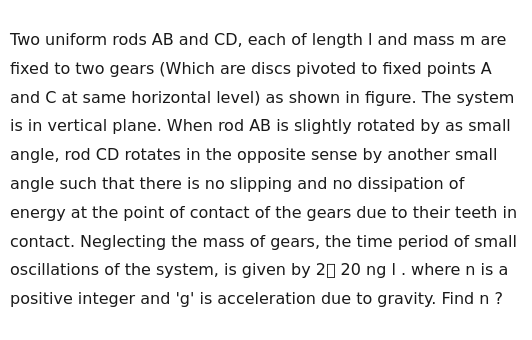Question
Question: Two uniform rods AB and CD, each of length l and mass m are fixed to two gears (Which are discs piv...
Two uniform rods AB and CD, each of length l and mass m are fixed to two gears (Which are discs pivoted to fixed points A and C at same horizontal level) as shown in figure. The system is in vertical plane. When rod AB is slightly rotated by as small angle, rod CD rotates in the opposite sense by another small angle such that there is no slipping and no dissipation of energy at the point of contact of the gears due to their teeth in contact. Neglecting the mass of gears, the time period of small oscillations of the system, is given by 2 20 ng l . where n is a positive integer and 'g' is acceleration due to gravity. Find n ?

30
Solution
Let θ be the small angle of rotation of rod AB from the vertical, and ϕ be the small angle of rotation of rod CD from the vertical. Let clockwise rotation be positive for AB and counter-clockwise rotation be positive for CD, consistent with the statement that CD rotates in the opposite sense.
Let rA and rC be the radii of the gears attached to rods AB and CD respectively. Since the gears are in contact and there is no slipping, the tangential displacement at the point of contact must be the same. Thus, rAθ=rCϕ, which gives ϕ=rCrAθ. Let k=rCrA. So, ϕ=kθ.
Differentiating with respect to time, we get ϕ˙=kθ˙.
The total kinetic energy of the system is the sum of the kinetic energies of the two rods. Each rod is a uniform rod of mass m and length l rotating about one end. The moment of inertia of a uniform rod about an axis through one end and perpendicular to the rod is I=31ml2.
KE=KEAB+KECD=21Iθ˙2+21Iϕ˙2=21(31ml2)θ˙2+21(31ml2)ϕ˙2=61ml2(θ˙2+ϕ˙2).
Substituting ϕ˙=kθ˙, we get KE=61ml2(θ˙2+(kθ˙)2)=61ml2(1+k2)θ˙2.
The total potential energy of the system is the sum of the potential energies of the two rods due to gravity. We take the equilibrium position (rods hanging vertically downwards) as the reference level for potential energy (PE=0).
When a rod is rotated by a small angle α from the vertical, the center of mass (at l/2 from the pivot) is raised by a height h=2l(1−cosα). For small α, cosα≈1−2α2, so h≈2l(1−(1−2α2))=4lα2.
The potential energy of rod AB is PEAB=mghAB=mg2l(1−cosθ). For small θ, PEAB≈mg4lθ2.
The potential energy of rod CD is PECD=mghCD=mg2l(1−cosϕ). For small ϕ, PECD≈mg4lϕ2.
The total potential energy is PE=PEAB+PECD≈41mglθ2+41mglϕ2.
Substituting ϕ=kθ, we get PE=41mglθ2+41mgl(kθ)2=41mgl(1+k2)θ2.
The total energy of the system is E=KE+PE=61ml2(1+k2)θ˙2+41mgl(1+k2)θ2.
For small oscillations, energy is conserved, so dtdE=0.
dtd[61ml2(1+k2)θ˙2+41mgl(1+k2)θ2]=0
61ml2(1+k2)(2θ˙θ¨)+41mgl(1+k2)(2θθ˙)=0
Assuming θ˙=0 (for oscillating motion), we can divide by 2θ˙ and by m(1+k2).
61l2θ¨+41glθ=0
θ¨+61l241glθ=0
θ¨+2l3gθ=0.
This is the equation of a simple harmonic oscillator of the form θ¨+ω2θ=0.
The angular frequency is ω2=2l3g, so ω=2l3g.
The time period of small oscillations is T=ω2π=2π3g2l.
The problem states that the time period is given by 2πngl20.
Comparing this with our result T=2π3g2l, we need to match the terms inside the square root.
3g2l=ngl20.
Squaring both sides:
3g2l=ngl20
We need to rearrange the right side to match the form constant×gconstant×l.
Let's rewrite the given time period as T=2πn20gl1. This doesn't seem to match the form.
Let's re-read the given time period carefully: 2πngl20. This must be a typo in the question and it should be 2πng20l. Let's assume this is the case.
Comparing T=2π3g2l with T=2πng20l.
3g2l=ng20l
3g2l=ng20l
3g2=ng20
32=n20
2n=3×20=60
n=30.
Let's consider another possibility for the given time period expression: 2πn20gl.
Comparing T=2π3g2l with T=2πn20gl.
3g2l=n20gl
3g2l=n20gl
32=n20
2n=60
n=30.
Both interpretations of the likely typo lead to n=30. Given the options are usually positive integers, n=30 seems plausible.
Let's consider the possibility that the question meant 2πng20l. This is the most likely intended form.
